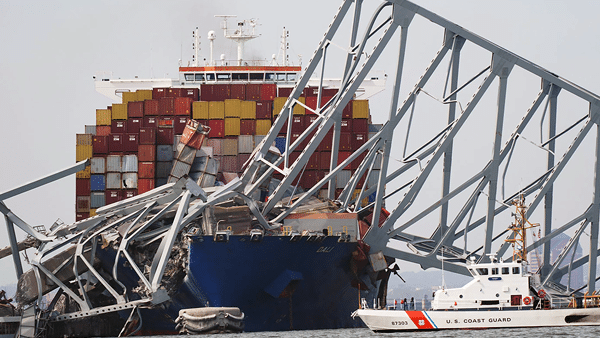Congress must insist on a loan against future insurance payments and that the bridge is rebuilt with a fast, responsible, and entrepreneurial approach.
The tragic collapse of the Francis Scott Key Bridge in Baltimore presents an important choice.
We can choose a fast, relatively inexpensive, entrepreneurial rebuild – or a slow, costly, bureaucratic one.
The Biden administration’s anti-entrepreneurial bias for leftwing regulators, union work rules, and virtually unlimited taxpayer funding could all turn the bridge rebuild into an unnecessarily long and expensive project.
There are enormous differences in cost and speed between the two approaches. An aggressive entrepreneurial approach includes incentives for speed and achievement. Paper ridden, red tape-defined, bureaucratic approaches typically let the general public suffer while special interests maximize their access to taxpayer funding.
Sean Kennedy recently captured this difference in the City Journal. He wrote: “Baltimore needs to restore the Francis Scott Key Bridge as quickly as possible—and a model exists to do so.”
Kennedy cited Minnesota Gov. Tim Pawlenty’s remarkable leadership when the I-35W bridge collapsed over the Mississippi River on Aug. 1, 2007. Thirteen people died and another 145 were injured.
Amazingly the bridge reopened within 14 months – three months ahead of schedule.
Gov. Pawlenty relentlessly pushed entrepreneurial approaches. As Kennedy reported: “Federal and state officials ‘fast-tracked’ the bridge’s reconstruction by reducing the regulatory burdens that hamper new construction projects-environmental, safety, labor, and contracting reviews.”
Using an entrepreneurial approach, the officials set a big bonus for the contractors if they got it done on time. They also built in a penalty if the contractors missed their targets. As Kennedy noted, “Crews worked around the clock every day, right through the state’s notorious winter weather.”
Kennedy contrasted this entrepreneurial approach with the rebuilding of the Bayonne Bridge between Staten Island and New Jersey. That project took from 2009 to 2017 and saw significant cost overruns. He also noted, “A much-heralded bridge spanning the Mississippi between Illinois and Iowa across I-74 was more than three decades in the making and ran significantly over budget.”
I reached out to Gov. Pawlenty for his input on this column. He said the stage could be set for a rapid rebuild in Baltimore. As he wrote, it would require: “use of design/build process; heavy use of incentives and disincentives for timeliness; accelerated (but not diminished quality) regulatory/permitting reviews; and great teamwork between local, state, and federal officials.”
As Minnesota political analyst Barry Casselman, wrote, the I-35W project was “A rare case of a public works project finishing not only on time.” He added that the approach really mattered. Another major bridge project in Minneapolis, the Third Avenue Bridge, was renovated under a Democratic-Farmer-Labor Party administration. That project took three-and-a-half years – and it didn’t even require a full rebuild.
We have plenty of other examples of bureaucratic-political public works projects becoming absurdly expensive and taking far too long.
As Spectrum 1 News reported in September 2019 on the New York subway system, “The MTA pays the highest construction costs of any transit agency in the world and it has repeatedly blown budgets and deadlines on large projects.
“In announcing the plan, the MTA did not announce any union reforms that could bring down costs. Its chief construction officer says the agency is working on ways to reduce overruns, for example, by improving planning to avoid changing designs in the middle of a project.”
Perhaps the most infamous recent public works disaster was the $14.8 billion “Big Dig” in Boston.
As NBC News reported in December 2007:
“When the clock runs out on 2007, Boston will quietly mark the end of one of the most tumultuous eras in the city’s history: The Big Dig, the nation’s most complex and costliest highway project, will officially come to an end.
“Don’t expect any champagne toasts.
“After a history marked by engineering triumphs, [tunnel] leaks, epic traffic jams, last year’s death of a motorist crushed by falling concrete panels and a price tag that soared from $2.6 billion to a staggering $14.8 billion, there’s little appetite for celebration.”
The federal, state, and local officials trying to rebuild the Francis Scott Key Bridge should learn the lessons of history and apply the entrepreneurial approach to fast reconstruction.
Finally, while Congress should loan the money to rebuild the bridge, it should also insist that the shipping company responsible for destroying the bridge – and therefore its insurance company – pays for the cost of the failure.
After all of President Joe Biden’s attacks on supposedly greedy corporations, it is ridiculous that his first reaction to the Francis Scott Key Bridge disaster was to bail out the shipping and insurance companies with taxpayer dollars.
Congress must insist on a loan against future insurance payments and that the bridge is rebuilt with a fast, responsible, and entrepreneurial approach.
For more commentary from Newt Gingrich, visit Gingrich360.com. Also, subscribe to the Newt’s World podcast.
Get Newt’s Latest Book:


Newt’s Latest Articles:
- How AI is Changing the World
- The Judge’s Democratic Operative Daughter
- Speaker Johnson and Governor Reagan
- Republicans Want to Help Americans Leave Poverty
- Democrats Seek to Subvert Democracy Itself












